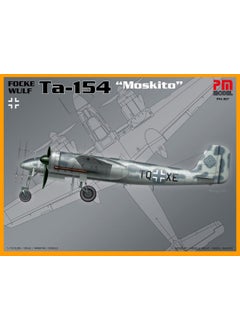Free & Easy Returns
Best Deals
| Material | Plastic |
PM Model 307 1/72 Focke-Wulf Ta 154 Moskito Night Fighter Disassembled Plastic Model
SCALE: 1/72
Type: Disassembled Kit (Requires assembly and painting)
MATERIAL: PLASTIC
CONTENTS:
Plastic Injection Parts
1 Decal
1 Installation Manual
FEATURES:
It is made of disassembled plastic.
Glue and paint are not included in the box.
You can easily carry out the necessary assembly operations with the included assembly guide.
ABOUT:
Kurt Tank's team at Focke-Wulf had been working on a fast attack-bomber called the Ta 211 for some time, so named because it planned to use an upgraded Jumo 211R engine. The intended "Ta 211" design was a high-wing twin-engine design made primarily from plywood, bonded with a special phenolic resin adhesive called Tego film. The only large-scale use of the metal was in the pressurized cockpit. When it became clear that the most suitable engine for the aircraft was the more powerful Jumo 213 and which Junkers could not deliver, the designation of the project was changed to Reichsluftfahrtministerium (RLM - Ministry of Aviation) 8-154 (hence Ta 154) airframe. At the time of Jumo 211R due to technical and production problems. The 154 was also assigned the name "Moskito" as a form of recognition of the Royal Air Force's (RAF) de Havilland Mosquito. Around this time, the lightweight and very fast de Havilland Mosquito, also made of wood, reached Germany. He quickly set an impressive record; In the first 600 bombing missions, RAF medium and heavy bombers averaged 5% Compared to , only one was shot down . Erhard Milch personally wanted a purposeful German response and chose 154. Infighting within German circles began almost immediately, as the RLM and night combat units – and Ernst Heinkel himself – still wanted the Heinkel He 219. Milch took this personally and spent much of the next two years fighting against Ernst Heinkel's wishes. spent 219 years trying to terminate the program.
